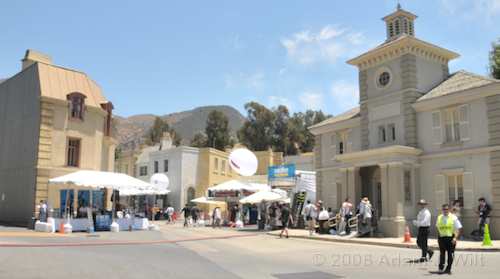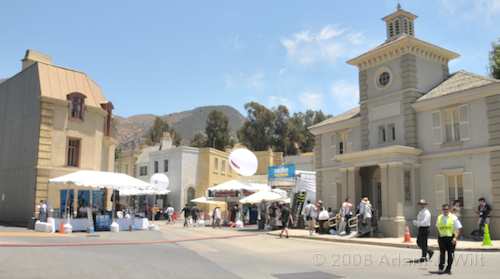
Cine Gear Expo on the blazing-hot Universal backlot
Day 2 of Cine Gear Expo dawned sunny and hot—our in-car temperature display registered 102 degrees Fahrenheit by 1:30pm. Despite the heat, there were plenty of things worth seeing.
European Village, at siesta time.
The picture above is atypical; most of the time, the “streets” of the “cities” in which Cine Gear Expo was staged were jammed with people. But even then, at 11:27am, the heat was causing folks to look for shade.
The backside of a backlot building.
The show took place on the Universal Studios backlot, amidst empty building shells and false fronts. Walking from one end of the show to the other took one from cobblestoned European courtyards to the dusty streets of a Western frontier town (albeit streets with a smoothly-paved concrete center section, all the better for smooth dolly moves).
Unlike my scattershot coverage of Day 1, I’ve tried to impose some order on this day’s coverage (apologies for being four days late, too).
Film Cameras
“Film is dead?” Not by a long shot, especially when it comes to slo-mo. Photo-Sonics is perhaps the best-known supplier of high-speed film cams in both 16mm and 35mm. One of their 35mm cameras runs at up to 360 fps, a 15x slowdown. It’s an impressively-engineered bit of gear.
The film transport of a Photo-Sonics 360 fps 35mm camera.
Photo-Sonics had a cutaway movement in a plexiglass box. Twelve pull-down pins, and four registration pins! This movement gets oiled when a new magazine is loaded, and the movement is built loose: it heats up at speed, and expands to fit its design tolerances.
Photo-Sonics guts revealed.
If 360 fps isn’t slow enough, Millisecond Cinematography offers a drum camera capturing at frame rates from 120 fps to 12,000 fps (5x to 500x slowdown).
The Millisecond camera: it holds only 120 frames of 35mm film…
…but it can expose them at up to 12,000fps!
My pick for most lust-worthy bit of film kit? Aaton‘s Penelope, a 2-perf/3-perf 35mm handheld camera. Check out that trademark wooden handgrip.
Aaton’s Penelope, with a Master Prime.
It’s as if Aaton shrink-wraps metal around the transport mechanism and the film, resulting in the most elegant, minimalist packages around. Aaton says that camera should rest “like a cat on your shoulder”, and the focus on ergonomics is apparent.
Side view of Penelope.
The camera has an integral video tap as well as a big, bright optical finder. The array of silver pushbuttons will have proper labels once this prototype goes into production.
The business end of the Penelope / Master Prime combo.
(While we’re discussing Aaton, their Cantar-X audio recorder was shown by Location Sound. I didn’t get any pix as the Cantar needs to be powered up for its meters to come alive, but there are good images on Aaton’s website.)
Lenses and Controllers
Innovision now has probe lenses for 72mm-threaded camcorders, like the HVX200.
Innovision’s probe lens on an HVX200.
DALSA had a big display of 4K digital cine cams, recorders, and support gear, and they also had a showcase full of lenses. I hadn’t known before that DALDSA had their own glass. But something else snuck in amongst the Master Primes and DALSA lenses…
DALSA prime lenses… and a Lensbaby!
cmotion has shown this handcrafted camera at several Cine Gear Expos.
cmotion’s famous handcrafted wooden camera. Oh, yes: they make lens controls, too.
It’s a BFD that the Bartech Focus Device (a wireless lens controller) has a motor that can drive even the stiffest of lenses. It’s reasonably priced, too, at “only” US$4600 (and no, I’m not being sarcastic: that’s a good price).
Bartech Focus Device: BFD!
Camera support systems are a dime a dozen (or, well, $1500/each, on average, plus accessories), but the CineTech stuff stands out for its wooden focusing knobs, lightening holes (look at the support rods on the shelf below the follow-focus), and almost over-the-top machining.
CineTech always has the most elegant follow-focus systems.
Next: Lighting, camera support, more RED stuff, etc…
Lighting and Lighting Control
Bron Kobold had a number of HMIs, including the weatherproof 800W unit demoed in a pool of water, with a sprayer above it, and the overwhelming, 7.2 foot diameter Para reflector system.
Bron Kobold HMI, standing in a pool with water dripping on it.
Bron’s big Para reflector.
Rololight‘s flexible fluorescent system uses Kinoflo tubes, but puts each one on its own fixture. Fixtures can be linked with piano-hinge pins, and rolled up, spread out, or wrapped around things as needed.
Rololights: flexible fluorescents.
I don’t recall who had this ringlight, but it’s a self-contained unit (note the power supply under the EX1). It was designed for the HVX200, but fits most cameras of a similar size.
This LED ringlight fits most small cameras.
Rosco VIEW combines sheet polarizers on windows with a rotatable polarizer on-camera. By rotating the camera’s polarizer, you can dim the windows to match your interior lighting.
Rosco VIEW demonstrated (polarizing film, plus an on-camera polarizer).
If it’s reflections you need to worry about, Motion Light Design‘s POLA-DISC goes between light and subject. You can spin it with a handheld controller, and kill reflections on the subject without rotating the polarizer on the lens: handy if you have multiple lights, but need to vary the reflections caused by only one. In the image, note the camcorder’s screen, and the appearance of the Pola-Disc as seen by the camera.
Pola-Disc: motorized, rotating lighting polarizer.
Camera Support
P+S Technik’s Skater dolly can be fitted with a tilt module, so you can vary the camera’s tilt with fluid-head smoothness even as you skate around your subject.
The Skater Dolly now has a tilt head option
Servo mounts for motorcycles? If there’s somewhere you need a camera put, rest assured that someone in Hollywood has a rig to do it.
Motorcycle mount..
We saw this contraption at NAB, but here it’s flying a RED ONE camera. Note the use of the RED battery/drive cages as counterweights.
It’s the Steadicam-on-a-Segway, flying a RED ONE.
REDs were all over the place. Here, one’s in a gyro mount (e.g., for helicopter use).
A RED in a gyro mount. Note the counterweights.
Cranes like the Techno and this Super Scorpio (here at Service Vision‘s booth [Flash website]) let the camera fly free in three dimensions—but require moving counterbalance systems to keep from toppling over as the crane arm extends.
Sliding counterweights on this Super Scorpio crane keep it balanced as the head extends.
If that’s too high-end, and you just want something smooth, or at least not jarringly rough, how about a dolly with only 2.4 psi in the tires?
Squishy-tired dolly.
It’s like riding a pillow: don’t count on repeatability or precision (the tires are too soft and wobbly for that), but there’s no cushier ride for a camera operator.
Even More RED Stuff
Toys4RED.com is the combination of Air Sea Land Gear, Inc. and Tribor Design, Inc., coming together to fix RED’s inadequacies.
Toys4Red’s fix for RED’s oddball connectors.
Their first product is a side panel adapter to give the RED ONE industry-standard I/O connectors (albeit with only three of the four audio channels converted to XLRs on the side panel), and to provide the RED ONE with a level-controllable headphone jack: use the menus to set the monitor level to maximum, then use the Toys4RED panel’s rotary control, just like on any self-respecting bit of real audio gear.
Toys4Red offers a remote connector panel (up to 50 feet away).
They also offer a remote breakout box (this time, there’s room for all four audio channels to have XLRs), which puts standard I/O spigots up to 15 meters away: great for use on camera cranes and jib arms. Yes, it even includes the headphone jack and volume control.
The Toys4Red T-shirt explains it all.
Toys4RED joins Element Technica and Sim Video in fixing what’s broken with RED’s mechanical design, and in extending the camera’s usefulness and flexibility. We now have three different side-panel adapters to choose from; one remote breakout box, two EVF holders, cheese plates, and more; it’s almost as if the RED ONE were an iPod, when you look at how many third parties are putting serious resources into supplying accessories.
Etc.
The record-breaking heat was a problem; it’s hard to focus on equipment when you’re busy just surviving an oven-like environment. Several vendors had slushie machines that stubbornly refused to make slushies, while others had stocks of water bottles that were rapidly depleted.
Band Pro had a water cooler, and if you allowed them to scan your card, they gave you a nice, quart-sized refillable bottle filled with cold water.
Water by BandPro.
When one cooler bottle was emptied, it was replaced with another, and a “powered by BandPro” label was applied to it.
Band Pro and Abel Cine shared a single prototype Sony EX3, which they passed back and forth, each having ownership for half a day at a time. Band Pro said (and Sony later confirmed) that the EX3’s MSRP will be under US$10,000, with a street price in the mid-$8000 range. It should ship in about a month (and I hope to have a “first look” review of a prototype in the next couple of weeks).
There were lots more weird, wonderful, and wacky things to see: a spring-loaded, servo-stabilized camera head, mounted on a Fisher dolly (and a poor grip, whose job it was to push that dolly back and forth repeatedly over some cable guards to demonstrate the effectiveness of the stabilization—in open sunlight, in 100-degree-plus weather!); Fisher and Panther and Matthews dollies in every size, shape, and price range; car rigs; R/C camera copters; lighting booms; even cable-driven extensible microphone booms with, um, two operators?
Boom operator with assistant.
There’s really nothing quite like Cine Gear Expo if you’re into this sort of thing; NAB and IBC are too big and too diverse, and don’t manage to get as many of the quirky, one-off creations that the Hollywood environment encourages. It’s worth the trip if you’re anywhere near L.A. or can find an excuse to make the journey.
But, Cine Gear folks, you might consider having the next one in a climate-controlled area…

